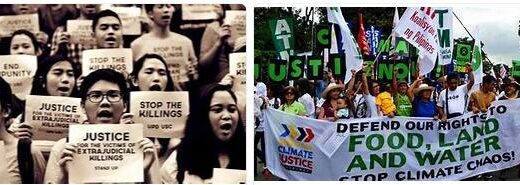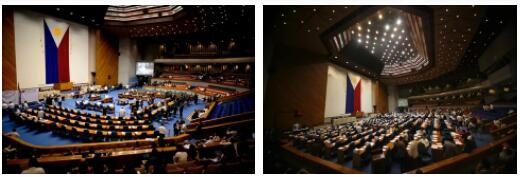Philippines Population 2000
Island state of Southeast Asia. The population of Philippines continues to grow at a rapid pace, and 76,498,735 residents recorded at the 2000 census rose, to a 2005 estimate, to 83,054,000. The composition by age is unbalanced: over a third of the residents are under the age of 15, while the population over 65 represents only 4 % of the total. The pressure on resources has remained considerable, and the level of economic and social development is tending to decline. According to World Bank estimates, more than half of the population survives on less than 2dollars a day, and a third of children suffer from malnutrition. Emigration remained the only relief valve, and Filipinos working abroad exceeded 6 million. The process of urbanization, caused by a strong rural exodus, has remained at high levels, and has resulted in the proliferation of shanty towns that have sprung up around the large cities. The phenomenon has assumed macroscopic dimensions in the capital Manila (14,950,000 the entire urban agglomeration, according to estimates in 2006) which is considered one of the five most polluted cities in the world.The economic situation is affected by the political uncertainties of a country in the throes of repeated violence, mainly due to the Muslim separatist guerrillas and the communist guerrillas (see below: History). Agriculture is penalized by the low level of infrastructure, the limited use of modern technology and the excessive dependence on climatic conditions. Among the crops destined for self-consumption predominate rice and corn, among those destined for export the coconut palm, bananas, pineapple, coffee, cocoa, sugar cane and tobacco. The forest heritage, severely damaged by the fires of 1998 and 2002, still produces considerable quantities of timber (16 million m 3 in 2004). Breeding is practiced mainly by large companies, particularly in the islands of Mindanao and Masbate, while fishing is widespread.
During the decade between the two centuries, the contribution of the industrial sector to the formation of GDP increased, while in the same period the share of the active population in the sector remained substantially unchanged, with a correlated increase in productivity. Consequently, the industry has reached a fair degree of diversification and, while remaining based on transformation (agri-food and textile-clothing), has enormously developed the electronic supply chain, which ensures two thirds of the country’s exports. Heavy industry is also significant, producing mainly cement, chemicals (in particular fertilizers and petroleum derivatives), processed metals.
The most dynamic productive sector and with the greatest increase in terms of contribution to GDP is that of services, which now participates for more than half of the country’s total income. Alongside the strong growth of the traditional tertiary sector, and also of financial and commercial activities, some innovative services have taken on an important role, intended for multinational companies which, through relocation, are looking for a reduction in production costs: thus the Philippines saw call-centers and other business process outsourcings set up in their territory more and more(BPO), although some local shortcomings, such as the lack of qualified staff able to speak English, have been a brake on this phenomenon, and competition from the Indian Union has been felt. Another source of foreign currency is represented by international tourism; In particular, attempts were made to attract the ‘new rich’ class of the People’s Republic of China. Despite the government’s efforts to implement important economic reforms, the country still has numerous structural handicaps: heavy public debt, high unemployment rates, a drop in foreign investments, limited tax revenues.



